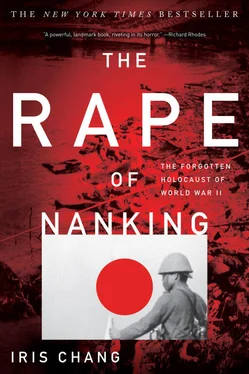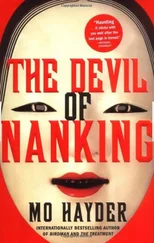The killing spree lasted for about an hour. While Tang lay still, feigning death, the Japanese pushed the rest of the bodies on top of him. Then, as Tang recalls, most of the soldiers left the scene except for one who thrust his bayonet into the mass grave repeatedly to make sure everyone was dead. Tang suffered five bayonet wounds without a scream, and then fainted.
Later that afternoon, at about 5:00 P.M., Tang’s fellow apprentices Big Monk and Small Monk came to the pit, hoping to retrieve his corpse. Through a crack in the brick wall of their house, they had seen the Japanese herd Tang and the others away and assumed that he was now dead with all the others. But when they found Tang moving under the heap of bodies, they pulled him out immediately and ushered him back to the house.
Out of the hundreds of people killed that day during the competition, Tang was the only survivor.
The torture that the Japanese inflicted upon the native population at Nanking almost surpasses the limits of human comprehension. Here are only a few examples:
—Live burials: The Japanese directed burial operations with the precision and efficiency of an assembly line. Soldiers would force one group of Chinese captives to dig a grave, a second group to bury the first, and then a third group to bury the second and so on. Some victims were partially buried to their chests or necks so that they would endure further agony, such as being hacked to pieces by swords or run over by horses and tanks.
—Mutilation: The Japanese not only disemboweled, decapitated, and dismembered victims but performed more excruciating varieties of torture. Throughout the city they nailed prisoners to wooden boards and ran over them with tanks, crucified them to trees and electrical posts, carved long strips of flesh from them, and used them for bayonet practice. At least one hundred men reportedly had their eyes gouged out and their noses and ears hacked off before being set on fire. Another group of two hundred Chinese soldiers and civilians were stripped naked, tied to columns and doors of a school, and then stabbed by zhuizi —special needles with handles on them—in hundreds of points along their bodies, including their mouths, throats, and eyes.
—Death by fire: The Japanese subjected large crowds of victims to mass incineration. In Hsiakwan a Japanese soldier bound Chinese captives together, ten at a time, and pushed them into a pit, where they were sprayed with gasoline and ignited. On Taiping Road, the Japanese ordered a large number of shop clerks to extinguish a fire, then bound them together with rope and threw them into the blaze. Japanese soldiers even devised games with fire. One method of entertainment was to drive mobs of Chinese to the top stories or roofs of buildings, tear down the stairs, and set the bottom floors on fire. Many such victims committed suicide by jumping out windows or off rooftops. Another form of amusement involved dousing victims with fuel, shooting them, and watching them explode into flame. In one infamous incident, Japanese soldiers forced hundreds of men, women, and children into a square, soaked them with gasoline, and then fired on them with machine guns.
—Death by ice: Thousands of victims were intentionally frozen to death during the Rape of Nanking. For instance, Japanese soldiers forced hundreds of Chinese prisoners to march to the edge of a frozen pond, where they were ordered to strip naked, break the ice, and plunge into the water to go “fishing.” Their bodies hardened into floating targets that were immediately riddled with Japanese bullets. In another incident, the Japanese tied up a group of refugees, flung them into a shallow pond, and bombarded them with hand grenades, causing “an explosive shower of blood and flesh.”
—Death by dogs: One diabolical means of torture was to bury victims to their waist and watch them get ripped apart by German shepherds. Witnesses saw Japanese soldiers strip a victim naked and direct German shepherds to bite the sensitive areas of his body. The dogs not only ripped open his belly but jerked out his intestines along the ground for a distance.
The incidents mentioned above are only a fraction of the methods that the Japanese used to torment their victims. The Japanese saturated victims in acid, impaled babies with bayonets, hung people by their tongues. One Japanese reporter who later investigated the Rape of Nanking learned that at least one Japanese soldier tore the heart and liver out of a Chinese victim to eat them. Even genitals, apparently, were consumed: a Chinese soldier who escaped from Japanese custody saw several dead people in the streets with their penises cut off. He was later told that the penises were sold to Japanese customers who believed that eating them would increase virility.
If the scale and nature of the executions in Nanking are difficult for us to comprehend, so are the scale and nature of the rapes.
Certainly it was one of the greatest mass rapes in world history. Susan Brownmiller, author of the landmark book Against Our Will: Men, Women and Rape, believes that the Rape of Nanking was probably the single worst instance of wartime rape inflicted on a civilian population with the sole exception of the treatment of Bengali women by Pakistani soldiers in 1971. (An estimated 200,000–400,000 women were raped in Bangladesh during a nine-month reign of terror following a failed rebellion.) Brownmiller suspects that the Rape of Nanking surpasses in scale even the raping of women in the former Yugoslavia, though it is difficult for her to say for certain because of the unreliability of Bosnian rape statistics.
It is impossible to determine the exact number of women raped in Nanking. Estimates range from as low as twenty thousand to as high as eighty thousand. But what the Japanese did to the women of Nanking cannot be computed in a tally sheet of statistics. We will never know the full psychic toll, because many of the women who survived the ordeal found themselves pregnant, and the subject of Chinese women impregnated by Japanese rapists in Nanking is so sensitive that it has never been completely studied. To my knowledge and to the knowledge of the Chinese historians and officials at the memorial hall erected in memory of the Nanking massacre, not a single Chinese woman has to this day come forward to admit that her child was the result of rape. Many such children were secretly killed; according to an American sociologist in the city at the time of the massacre, numerous half-Japanese children were choked or drowned at birth. One can only guess at the guilt, shame, and self-loathing that Chinese women endured when they faced the choice of raising a child they could not love or committing infanticide. No doubt many women could not make that choice. Between 1937 and 1938 a German diplomat reported that “uncounted” Chinese women were taking their own lives by flinging themselves into the Yangtze River.
We do know, however, that it was very easy to be a rape victim in Nanking. The Japanese raped Nanking women from all classes: farm wives, students, teachers, white-collar and blue-collar workers, wives of YMCA employees, university professors, even Buddhist nuns, some of whom were gang-raped to death. And they were systematic in their recruitment of women. In Nanking Japanese soldiers searched for them constantly as they looted homes and dragged men off for execution. Some actually conducted door-to-door searches, demanding money and hua gu niang— young girls.
This posed a terrible dilemma for the city’s young women, who were not sure whether to remain at home or to seek refuge in the International Safety Zone—the neutral territory guarded by Americans and Europeans. If they stayed in their houses, they ran the risk of being raped in front of their families. But if they left home in search of the Safety Zone, they ran the risk of being captured by the Japanese in the streets. Traps lay everywhere for the Nanking women. For instance, the Japanese army fabricated stories about markets where women could exchange bags of rice and flour for chickens and ducks. But when women arrived on the scene prepared to trade, they found platoons of soldiers waiting for them. Some soldiers employed Chinese traitors to seek out prospective candidates for rape. Even in the Safety Zone, the Japanese staged incidents to lure foreigners away from the refugee camps, leaving women vulnerable to kidnapping raids.
Читать дальше











